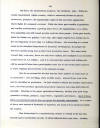|
George W. McCoy Collection
|
M1978.01.02 |
|
ADDRESS BY GOVERNOR LUTHER HODGES - June 20, 1960 |
|
Box |
File |
Item # |
Date |
Description |
Thumbnail |
| 2 |
2 |
gmc_064 |
|
FOR RELEASE:
12:00 noon,
Monday, June 20, 1960
ADDRESS BY GOVERNOR LUTHER H. HODGES
AT
WESTERN NORTH
CAROLINA INDUSTRIAL DEVELOPMENT CONFERENCE
Battery Park
Hotel Asheville, North Carolina Monday, June 20, 1960 12:00 noon
Having spent the
better portion of the past week in the great coastal region of our
State, it is good to come now to the West, to remind myself of the
great variety and beauty that ranges through North Carolina from the
seashore to the mountains. It is a thrilling and wonderful
experience to travel, as I have just done, over the broad expanse of
this State and to marvel at the tremendous activity, the enthusiasm
of the people and the confidence in the future that is evident today
and will be even more evident in the years ahead, if we handle our
affairs properly.
In the East, in
the Piedmont, and here in the West, things are on the move. Travel
through the Coastal Plain today and you will see not only the rich
green farm land yielding both new and traditional crops, but also
new industries, new processing plants and new business activity on
all sides. Visit the bustling industrial Piedmont and you find not
complacency, but a progressive spirit determined to continue
building on the comparative solid foundation that has been
established. And here in the West, we find people working together
as never before, and trying (as this meeting today proves) to
improve the situation in their several counties and this great
Western region.
This audience
represents one-fourth of the counties in the State. Nearly
three-quarters of a million North Carolinians are looking to you for
the local and regional leadership that will enable them to take
advantage of their opportunities, |
 |
| gmc_065 |
|
-2-
to move forward
along sound lines, and eventually realize and enjoy the higher
standard of living to which they are entitled.
This imposes
upon each of you a sizeable responsibility. And it is a
responsibility that extends beyond the confines of your own primary
interest, your own community or your own county. It is, first and
foremost, a regional responsibility which by its very nature implies
a State responsibility. You have made a good start toward meeting
this responsibility through the establishment of area development
associations. All but two of the counties represented at this
meeting hold membership in these associations and I am confident
that each of them has derived material benefit from such cooperative
efforts. Your Northwestern North Carolina, Western North Carolina
and Piedmont development organizations have certainly made
contributions to the economic progress of this region and you are to
be congratulated on the initiative and enthusiasm you have put into
these undertakings. But, and I think most of you will agree with me
on this, you have only begun to tap the vast resources available to
you.
It is the
purpose of this and the other three regional conferences that have
been held across the State to encourage the continuation and
expansion of your efforts and, as far as possible, to promote even
greater cooperation -- not just within your individual counties or
development associations or region.but throughout all of North
Carolina. No single community or county or section of this State has
a monopoly on good ideas. Each of us can learn something from the
other, and each has something to contribute. If this meeting serves
no other purpose than to provide a forum for the exchange of ideas,
then it will have been worthwhile.
I would like to
commend the Commerce and Industry Division of our Department of
Conservation and Development on its sponsorship of this event |
 |
| gmc_066 |
|
-3-
and on the initiative it has shown in arranging
an informative and comprehensive program. We are particularly
indebted to the speakers who have come here to share with us their
considerable knowledge and experience in the industrial development
field. Tom Dana of the General Electric Company in Hickory has
discussed with you the very important subject of "Business Climate
Appraisal" as it affects industrial development, and I can assure
you his observations and suggestions are most pertinent. You have
also heard Mr. R. D. Warwick of Statesville discuss what his
community has done to attract industry. I believe that we must all
agree the Statesville story is a good example of what one community
can do when it decides to make the best of its opportunities, and I
congratulate them for their accomplishments.
This afternoon you will hear Joseph Claud of
the American Commercial Bank of Charlotte discuss the increasingly
important matter of financing an industrial development program.
Later, Edd Perdue, Secretary-Treasurer of Clarendue Metal Products,
Incorporated, of Lenoir, will use his firm to illustrate the
benefits to be gained by organizing and developing industry at the
local level. All of these speakers are discussing subjects that must
be studied and explored in detail in every community and county that
approaches the subject of industrial development in a progressive,
business-like way. I do not say that you should adopt all the
suggestions or procedures outlined for you today, but I do say that
you should give them careful consideration to see if they are
applicable to your local or area situation.
Let me say at this time that I have not come
here today simply to lend the prestige of the Governor's office to
this occasion. Nor have I come to talk to you in vague terms about
the progress you have made, the problems you still face, or your
hopes for the future. On the contrary, I have come here today |
 |
| gmc_067 |
|
4-
to discuss facts and to be as practical and
helpful as possible. I would like, therefore, to lay the groundwork
for most of my remarks by looking individually at the 25 counties
represented here in the light of their per capita income and
population changes from 1950 to 1960.
(See statistical sheet attached.)
Certainly it is obvious from these figures
that you have your work cut out for you. The average per capita
income for the counties represented here is a little over $1,000
($1,003). Only two of your counties, Buncombe and Transylvania, have
per capita income above the State average of $1, 384. Fifteen of
your counties have per capita income averages of less than $1,000.
During the period of 1950 to 1960 sixteen of the counties
represented at this meeting lost population. While the State was
gaining 467,000 new citizens in the past ten years, this 25-county
area gained only 4,236. I cite these figures, not as criticism but
because we have come here today to deal in facts, to recognize our
problems and to seek out reasonable, workable solutions. And I am
sure you would not be here today if you did not agree that greater
industrialization is the key to solving many of our difficulties.
Look at the counties and their income, then look at their industries
and the type of industry. Don't lose any of them," get some more.
Most of you are, I am sure, aware of the fact
that economic progress doesn't just happen. Industries that are
planning to move their operations or expand do not simply draw a
name out of the hat and say, "This is it." The community or county
or region that sits back and waits for lightning to strike is |
 |
| gmc_068 |
|
5-
being extremely naive. Fortunately, we in North
Carolina have come to realize that an industry locates where the
cold, hard facts of good business practice dictate and that is in
an area that provides most of the basic essentials that are needed
by that particular industry to reasonably insure a successful
business operation. These essentials may differ somewhat with the
individual industry, but the really basic requirements remain
constant. One of the first pre requisites is, of course, an
attractive community with clean streets and attractive buildings.
Not infrequently, one of the first requests that an industry makes
of a community in which it is considering an investment is for a
picture of the main street. This has happened in North Carolina in
the past and it will happen again in the future. It could very well
happen to many of the communities represented here today. That is
why it is important that you overlook no details in preparing your
community for industrial development. Nothing is insignificant. Of
course, it is not always easy to look at your own community
objectively, but it is something you must do. You must ask yourself
if your community measures up, if its business district is modern
and progressive, if its facilities for cultural* religious,
educational and recreational activities are adequate and you must
answer these questions frankly. You must not say that we are as good
as some other community or that we have done everything that can be
done. You will be fooling yourselves only.
If you find that your community is lacking in
any respect, take it upon yourself to do something about it. Analyze
your problems objectively, take the time needed to develop your
plans intelligently, and then get on with the job.
Industry-community relationships are never so
ideal that they cannot be improved. Cultured, educational and
recreational facilities are never so |
 |
| gmc_069 |
|
6-
adequate that they cannot be expanded, A
constant re-appraisal of all facets of the industry-community
relationship is necessary if maximum benefit is to be derived at all
times. Industry, itself, spurred on by mounting expenditures for
research is an ever-changing economic factor. Practices and
procedures that were the ultimate in efficiency ten years ago have
become out-dated. New equipment has revolutionized some industries
overnight, confronting management with problems that could not even
have been imagined a short time ago. Economic pressures brought on
by domestic or foreign competition can vitally affect the operation
of your local industry without your even being aware of it.
All of these things present a challenge to
the people of the community to maintain close liaison with their
present industries and to stand ready at all times to strengthen and
encourage those industries in their constant battle with the
changing times. This is one of the responsibilities you accept when
you invite an industry to locate in your community, and it is
certainly a responsibility you owe to the older established
industries in your area.
I have no desire to duplicate what has been
said or will be said by the other speakers on your program here
today. For this reason, I will not go into detail on many items that
constitute the so-called "good business climate." I would like to
point out, however, that the final job of selling a community or
county or Region to a particular industry rests with the people at
the local level. That is why this conference is so important. The
State can do only so much. It can sell North Carolina, but it cannot
sell a particular community or county. We can and have done much to
build North Carolina's reputation as a State in which a good
business climate exists. Our success or failure in exploiting this
reputation can be determined only by those of you who, in the final
analysis, are called upon to lay goods on the line. If you are
prepared to do so, then you reap |
 |
| gmc_070 |
|
7-
the benefit of the total effort to sell North
Carolina. If you are not prepared, then you let down not only the
people of your own town and territory who depend upon you for
leadership, but the State that expects you to hold up your end of
the bargain. Never forget that in the eyes of the industrial
prospect your town represents not just an isolated community, but a
State that has acquired, and must maintain, a reputation for unique
business opportunity.
The prospect that comes to your town has been
told that the great strength of North Carolina is its people, that
they are cooperative, industrious, honest, progressive and possessed
of a pride that is justified by both historic
tradition and the
achievements of recent years. He has been assured that established
industries in your area will testify to the cooperative spirit of
your local government and the people of your community. He has been
told that he can expect fair and equitable tax treatment and that
his employees will be uniquely loyal and productive in return for
fair wages and good treatment. He has been told that the various
communities of North Carolina will make no unreasonable concession
and that we, as a State, are simply not interested in the kind of
industry that would require such concession. He has been told that
your cities and counties will provide good public schools, housing,
recreational and cultural facilities to insure the kind of community
that produces a stable labor force.
These promises have been made to thousands of
industrial prospects in this country and in Europe. They have been
made in good faith, based on the conviction that the people of North
Carolina are sufficiently dedicated to economic progress to continue
living up to the excellent reputation they have built for themselves
in recent years. It will require hard work, some sacrifice and
considerable determination to realize full advantage from our |
 |
| gmc_071 |
|
-8-
opportunities, I have never once, in the past
five and one-half years, indicated to the people of this State that
our ultimate goal, a higher standard of living, could be achieved
with less than maximum effort. On the contrary, I have stated
repeatedly, from one end of North Carolina to the other, that in the
race for industrial development and economic stability, our State
must run at top speed just to keep up.
The problem is even more difficult here in an
area of our State that obviously faces the task of not keeping up,
but catching up. Anl , while I do not offer this as consolation, I
will point out that you are not alone in this respect. Other areas
of the State, especially in the East, face a similar challenge.
There is every indication that they are facing up to the challenge,
just as you have been doing, and must continue to do, in this area.
Your problem here, while perhaps magnified, is not unlike that faced
by our State as a whole. Cur economy is undergoing a rather violent
upheaval. States that are traditionally dependent upon agriculture
as the mainstay of their economy have, in the past decade, seen
mechanization, acreage allotments, consumer requirements, foreign
competition and other factors knock the props from under the old
concepts of economic stability. The ideal now is a balance between
agricultural and non-agricultural employment. Simply stated, our
rural areas can no longer support the large numbers of our people
who formerly derived their income from farming. Unless we are to
lose these valuable citizens permanently, we must, obviously,
provide them new types of agricultural jobs or new industrial jobs.
I do not imply that we should forget about
farming and concentrate all our energies on industrial development.
We must seek the desirable balance. |
 |
| gmc_072 |
|
-9-
In a newspaper article published several weeks
ago. Professor Rupert B. Vance of the Sociology Department of the
University of North Carolina pointed out that, "The coming of new
industry has not injured our agricultural economy. It has helped the
farmer* Not only in new jobs for much of the displaced farm labor,
but in the increased demands for products of the farm. When cities
grow, new markets are created for farm products. Push and pull
forces causing out-migration and in-migration have been due to the
following factors.
"Out-migration: Farm unemployment due to
mechanization, better seed, better fertilizers, counsel to farmers
and resultant promotion of larger yields, so that ten farmers today
can produce what it took thirty farmers to produce three decades
ago; less need for manual laborers in cities; the mobile population
because of World War II and the continuation of the draft in the
Cold War.
"In-migration: New service industries in
addition to manufacturing plants. Growth in distributing industries.
"Five things that can be done to slow down
the out-migration and speed up the in-migration," said Dr. Vance,
are:
"1. More education at all levels, in colleges
and in the high schools, with emphasis on technical education,
vocational training in technical high schools.
"2. Diversification. We must get away from
the one-crop industry just as the South got away from cotton.
"3. Strive for industrialization,
selectively,
"4. Develop industries based on existing
crops, such as vegetable crops, seafood, cucumbers, strawberries.
Then when unemployment occurs |
 |
| gmc_073 |
|
10-
on the farms at the same time crop yields show
abundance, the unemployed can go into nearby food-processing.
"6, Use of employment agencies, to fit round
pegs into round holes. Both employers and employees could use
employment agencies to better advantage, for jobs in this State and
elsewhere.
Dr. Vance says an economy is better off when
industry and agriculture are in between. He says, "We have to face
certain realities about both agriculture and industry, the climate
and resources of our State and what we can do. North Carolina lacks
two things that are essential to large-scale industrial development;
these two things are: 1. Basic metals; coal, iron and steel. 2, Oil.
We have no Birmingham, and we don't have what Louisiana and Texas
have,
"To make up for these natural handicaps,
North Carolina has had to exercise greater initiative in developing
its resources, human and natural," said Professor Vance, "We have
done what New England did," he said, "New Englanders, lacking basic
metals and oil, stressed new skills watch-making, lock-making,
electronics, metals, manufacture of high cost and larger profit
products,"
I think there is an even more striking
example than New England to illustrate what can be accomplished,
even under adverse conditions, when a people are dedicated to
progress, I refer to the tiny country of Switzerland which is
remarkably similar to our Appalachian area in many respects. Its
terrain, its soil, its climate, its natural resources and even its
people --independent and industrious closely resemble those of our
Appalachian region. |
 |
| gmc_074 |
|
11-
But here, for all practical purposes, the
similarity ends. While the small, land-locked Alpine country, which
is extremely limited in natural resources, prospers, the Appalachian
region of this and other Appalachian States fights for economic
survival. "While the Swiss gain steadily in population and readily
accommodate a growing labor force, the Appalachians, as a whole,
lose population and still cannot provide work for their people. In
the past decade, while the Nation was gaining 17 per cent, this
region registered a decline due to the out-migration of more than
1,5 million citizens. And according to a recent study by the
Maryland Department of Economic Development, the people who left
were mostly young men in their most productive years. This same
study reveals that, even now, there are only three million jobs
available to accommodate a labor force of 3.5 million. And it is
estimated that another half million jobs will be needed if labor
force participation rates are to rise to the point required to raise
regional income levels to the national average.
How do we account for the fact that the Swiss
achieve so much more on so much less? For one thing, there is little
waste. Almost 80 per cent of the land is classified as productive.
On land similar to that in the counties represented here, the Swiss
produce agricultural products valued at more than $600,000,000
annually. Dairying is the major agricultural industry, but they also
grow large quantities of wheat, potatoes, sugar-beets, vegetables
and tobacco.
Most of these
items are processed where they are grown for domestic consumption.
As a matter of fact,a vast amount of foodstuffs is imported, but
much of it is processed within the country.
That Switzerland is a manufacturing country
is evident in the fact that electric-power production exceeds 10
billion kilowatt-hours per year. Leading |
 |
| gmc_075 |
|
12-
manufactures, other than food, are clocks and
watches, machinery, metalware, chemicals and dyes, textile knitted
goods and embroidery. Their people are highly trained in basic
education in technical and scientific subjects and in languages.
I think it is also significant that in
Switzerland around 33 per cent of its people are employed in
industry and handicrafts; whereas 64 per cent of the people in the
Appalachian region are deriving a major portion of their income from
the land. And while this represents six per cent of the Nation's
farm employment, the region produces only three per cent of the
total value of farm products. Obviously, there is a great need here
for re-appraisal of the entire economic picture.
I think I should point out that the North
Carolina portion of the Appalachian area is, in many ways, more
fortunate than similar areas in some of the other Appalachian States
involved the coal mining sections of West Virginia, for example.
The rather discouraging picture that can be applied, in a general
way, to the entire Appalachian region, need not necessarily apply
here in North Carolina. One reason is that we have a running start
on most of the region in the development of the tourist trade. This
is becoming an increasingly important factor in the economy of this
region and our entire State. We registered a significant increase in
income from the trav el industry in the past season and there is
every indication that new records will be set this year. Small
industries, including handicrafts, food processing, etc., have great
possibilities.
The most important factor, however, is the
attitude of the people here in this western section of North
Carolina. In the study I mentioned earlier pertaining to the
Appalachian region, it was suggested that one of the major obstacles |
 |
| gmc_076 |
|
13-
that would have to be overcome before the region
could advance is the "psychological attitudes associated with
prolonged economic difficulties." in other words, the people have
become discouraged. I do not believe this has happened here in your
area. I believe that the people here are well aware of their
opportunities and that they have what it takes to make the best of
those opportunities. This meeting today does not look to me like a
gathering of crepe hangers.
Our entire State still has a long way to go
before it begins to realize the benefits of its full potential, but
I am convinced that we are on the right road.
We have, I believe, already fashioned the
tools that will be needed to get the job done and the major tool
is industrial development. Another is diversification both in
agriculture and industry. Another is education. We must keep our
schools open, and improve them steadily. Another is stable, honest
government at both the local and State levels. And I hope each North
Carolinian will make it his personal responsibility to take part in
government and to vote at all elections thereby helping maintain
good government at all levels. And, finally, there is the spirit of
cooperation, shown here today which is most essential.
May I conclude by saying that while your
primary concern at this time is the development of a better life
through greater wealth in this region, you must not for a moment
forget that to build a better Piedmont, or East, or West, we must
all work together to build a better North Carolina and not have
jealousies or differences which divide us and retard our growth of
education, better government and higher standards of citizenship. |
 |
| gmc_077 |
|
-14-
I would like to thank each of you for coming
here today to participate in this conference and for giving me the
opportunity to speak to you. I wish you every success in your
efforts. |
 |
| gmc_078 |
|
COUNTIES |
POPULATION
(Gain or Loss
1950-1960) |
PER CAPITA INCOME
(1958 estimated) |
 |
|
ALEXANDER |
1021 |
$885 |
|
ALLEGHANY |
minus 434 |
849 |
|
ASHE |
minus 2131 |
941 |
|
AVERY |
minus 1381 |
538 |
|
BUNCOMBE |
2954 |
1539 |
|
BURKE |
6831 |
1198 |
|
CALDWELL |
5923 |
1285 |
|
CHEROKEE |
minus 2026 |
921 |
|
CLAY |
minus 523 |
565 |
|
CLEVELAND |
1020 |
1185 |
|
GRAHAM |
minus 437 |
880 |
|
HAYWOOD |
1874 |
1368 |
|
HENDERSON |
4896 |
1361 |
|
JACKSON |
minus 1562 |
730 |
|
McDOWELL |
816 |
1104 |
|
MACON |
minus 1327 |
923 |
|
MADISON |
minus 3485 |
725 |
|
MITCHELL |
minus 1256 |
923 |
|
POLK |
minus 397 |
1190 |
|
RUTHERFORD |
minus 2071 |
1192 |
|
SWAIN |
minus 1504 |
915 |
|
TRANSYLVANIA |
908 |
1490 |
|
WATAUGA |
minus 1010 |
746 |
|
WILKES |
minus 116 |
914 |
|
YANCEY |
minus 2307 |
714 |
|
Total Gain |
4236 |
|